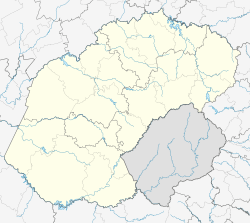Springfontein facts for kids
Quick facts for kids
Springfontein
|
|
|---|---|

Springfontein railway station
|
|
| Country | South Africa |
| Province | Free State |
| District | Xhariep |
| Municipality | Kopanong |
| Government | |
| • Type | Municipality |
| Area | |
| • Total | 16.5 km2 (6.4 sq mi) |
| Elevation | 1,515 m (4,970 ft) |
| Population
(2011)
|
|
| • Total | 3,699 |
| • Density | 224.2/km2 (580.6/sq mi) |
| Racial makeup (2011) | |
| • Black African | 75.1% |
| • Coloured | 21.1% |
| • Indian/Asian | 0.5% |
| • White | 3.1% |
| • Other | 0.1% |
| First languages (2011) | |
| • Xhosa | 41.5% |
| • Afrikaans | 28.9% |
| • Sotho | 22.8% |
| • Tswana | 3.1% |
| • Other | 3.8% |
| Time zone | UTC+2 (SAST) |
| Postal code (street) |
9917
|
| PO box |
9917
|
| Area code | 051 |
Springfontein is a small town in the Free State province of South Africa. It's known for its farms and its important railway station.
Contents
Discovering Springfontein's Past
Springfontein was officially started in 1904. It was built on a farm called Hartleydale. This farm was actually part of a bigger farm named Springfontein. The name "Springfontein" comes from the Afrikaans language and means "jumping fountain." This is because there was a natural spring on the farm.
In 1904, a local board was set up to manage the village. By 1912, Springfontein became a proper municipality. This means it had its own local government.
Farming and Railways in Springfontein
The area around Springfontein is great for farming. Farmers here raise sheep and cattle. They also grow crops like maize (corn). In the early 1900s, a company called Springfontein Creameries was a big employer. They likely processed milk and made dairy products.
Springfontein is also a very important railway hub. It's on the main train line that goes to Johannesburg. Trains from Bloemfontein, East London, and Port Elizabeth all meet here. There's also a train line that goes west to other towns in the Free State.
Springfontein During the Anglo-Boer War
During the Second Boer War, also known as the Anglo-Boer War, there was a British concentration camp near Springfontein. This camp was started in February 1901.
Life in the Concentration Camp
When the camp first opened, about 411 people were held there. William Gostling, a local official, was put in charge. Most of the people who arrived were poor farmers or farm workers. Many had very few clothes and no shoes. They had to make do with what little they had.
By the end of March 1901, hundreds more people arrived. This included many black people, especially from the Thaba’Nchu area. These people were kept in a separate camp. Conditions were very tough, and many people in this camp became sick and died.
Getting enough water was a big problem for the camp. The British military had their own bases nearby. They needed a lot of water, so they often used the dams that were meant for the concentration camp.
Overcrowding and Help from Bethulie
The Springfontein camp was built for only 500 people. But by April 1901, the war brought in almost 2,000 more people. This meant there weren't enough tents for everyone. To help with the overcrowding, another camp was set up in Bethulie.
Records show that 568 people of all ages died in the Springfontein camp between April and the end of 1901. Their graves can still be seen in the concentration camp cemetery. A woman named Emily Hobhouse visited the camp during the war. She was investigating the difficult conditions there.
The Welsh Hospital: A Place of Healing
During the war, many groups helped set up medical care. One special effort was the Welsh Hospital. This hospital was funded by donations from people in Wales. Professor Alfred W. Hughes from Corris helped start it.
Moving the Hospital to Springfontein
The hospital was first meant to be in Bloemfontein. But there was a serious outbreak of typhoid fever there. Many British soldiers were getting sick and dying. So, the hospital was moved to Springfontein instead. Springfontein was a good choice because it was an important railway junction.
The Welsh Hospital opened in May 1900. But soon after, many of the doctors and nurses got sick with dysentery. They also had to deal with typhoid among the wounded soldiers they were treating. Despite these challenges, by July 1900, the Welsh Hospital in Springfontein was considered one of the best military hospitals during the war.
Later, the hospital was ordered to move its base to Pretoria. It's estimated that the Welsh Hospital treated a total of 1,107 patients. Sadly, Professor Hughes, who founded the hospital, died from typhoid that he caught while working there.
The Magician's Last Trick
In 1930, a sad accident happened in Springfontein. A magician named Charles Rowan was performing a dangerous trick. He was trying to escape from a straitjacket. During the act, he was run over by a car. Charles Rowan died from his injuries.



